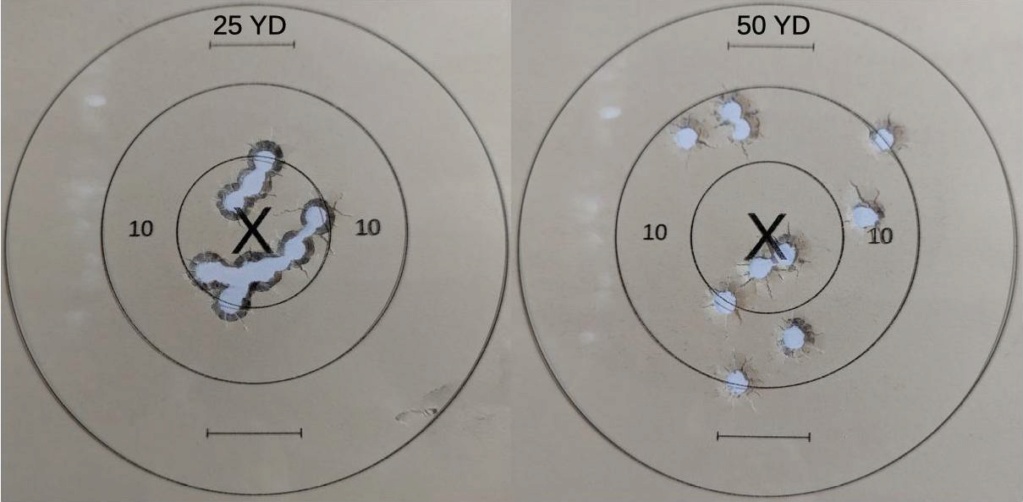45ACP Zero 185 JHP, 4.2 N310 Test Targets (25Y & 50Y)
+7
JHHolliday
Allgoodhits
BE Mike
sharkdoctor
Wobbley
samtoast
Chase Turner
11 posters
Page 2 of 2
Page 2 of 2 •  1, 2
1, 2
 45ACP Zero 185 JHP, 4.2 N310 Test Targets (25Y & 50Y)
45ACP Zero 185 JHP, 4.2 N310 Test Targets (25Y & 50Y)
First topic message reminder :
Hello,
There is often a disconnect between a load that performs well at 25Y and one that performs well at 50Y. I don't have enough data to convincingly say, "If you get x size group at 25Y, you should see y group at 50Y," but I'm starting to put together enough to potentially make some heuristics that one can use to determine if they should continue down a particular load development path. Consider the below example:

A 100-10X group can easily become a 100-3X group. Or worse- and never better. But: in any case and this one in particular as it as rather famous load, either is still a 100, which is what we should be concerned with.
Looking at the groups, it would be easy for someone to look at both and consider them non-related. But of course they are the same group, captured at 25Y and 50Y. Breaking down our inclination that we have towards categorizing what we see with symmetry and instead categorizing for score is probably the first stepping stone to a better understanding of how we do or do not call shots.
Best,
Chase
Hello,
There is often a disconnect between a load that performs well at 25Y and one that performs well at 50Y. I don't have enough data to convincingly say, "If you get x size group at 25Y, you should see y group at 50Y," but I'm starting to put together enough to potentially make some heuristics that one can use to determine if they should continue down a particular load development path. Consider the below example:

A 100-10X group can easily become a 100-3X group. Or worse- and never better. But: in any case and this one in particular as it as rather famous load, either is still a 100, which is what we should be concerned with.
Looking at the groups, it would be easy for someone to look at both and consider them non-related. But of course they are the same group, captured at 25Y and 50Y. Breaking down our inclination that we have towards categorizing what we see with symmetry and instead categorizing for score is probably the first stepping stone to a better understanding of how we do or do not call shots.
Best,
Chase
Chase Turner- Posts : 372
Join date : 2019-11-15
SingleActionAndrew, shanneba and samtoast like this post
 Re: 45ACP Zero 185 JHP, 4.2 N310 Test Targets (25Y & 50Y)
Re: 45ACP Zero 185 JHP, 4.2 N310 Test Targets (25Y & 50Y)
Well hey now, your original topic is fascinating but tell us about this SWC load that you've chosen to show us grouping tighter than the JHPs?
Also I'd think it interesting to see a B16 overlay on the 25 yards. Somewhat of a different purpose, but for those of us who have limited access to shoot at 50 yards and want to extrapolate from 25 yards using your demonstrations here.
Also I'd think it interesting to see a B16 overlay on the 25 yards. Somewhat of a different purpose, but for those of us who have limited access to shoot at 50 yards and want to extrapolate from 25 yards using your demonstrations here.

SingleActionAndrew- Admin
- Posts : 634
Join date : 2019-11-19
Location : IL, USA
 Re: 45ACP Zero 185 JHP, 4.2 N310 Test Targets (25Y & 50Y)
Re: 45ACP Zero 185 JHP, 4.2 N310 Test Targets (25Y & 50Y)
Chase Turner wrote:
1) What number of shots would you recommend to have a meaningful confidence interval? My thought is 60, but willing to entertain a different figure if it makes more sense (95% should be good enough, understand it would be more for 99%)
2) Is there a particular group size measurement that you believe would lend itself to more robust results?
3) The plan is to use TARAN to build composite groups from 10 shot strings. Let's say I have 100 shots in a group, or 10 strings. Is there a good rule of thumb on how to compare smaller quantities of shots against the larger one? I guess Students distribution is good to some number before large groups take over... Put another way- let's say I have a well documented test barrel. All sorts of loads. When would be ideal, in terms of sample size, to reject/compare/analyze a small number of shots/strings/composite groups against the entire corpus, while having meaningful results?
Thanks,
Chase
1. The number of shots needed to show statistical significance in difference of means depends on the size of the effect in question. ie, smaller effect requires larger N. That said your guess of 60 seems about right.
2. It seems there are at least two questions being discussed: Does the score change for the same shot at 25Y and 50Y? How/why are groups at 50Y different than at 25Y? Do barrel choice, bullets, powder load affect this? (I'm most interested in the 2nd question, and if true, what physically explains it).
I think radial distance from the group centroid - for each shot - would be a good measurement at 25 and 50. ie, for each shot, how far from the centroid did it impact the target at 25 and again at 50? For comparable radial measurements use either angular measure (mrad, etc) of each shot from the centroid, or linear measure on target (mm) and divide the 50Y measurements by 2.
3. Another "it depends". If the master and test distributions have low standard deviation you will see significant differences at lower N. If distributions have large STD, differences will be harder to detect.
If you get data on this I would be happy to look at ways to analyze the stats.
JHH

JHHolliday- Posts : 214
Join date : 2022-12-15
Chase Turner likes this post
Page 2 of 2 •  1, 2
1, 2
 Similar topics
Similar topics» Evansville-Chrysler 1942 230gr Ball Ammo Test Targets (25Y & 50Y)
» N310 less expensive than Bullseye
» Vv N310 and a dot
» VV N310 in 148 gr. WC
» VV N310 available
» N310 less expensive than Bullseye
» Vv N310 and a dot
» VV N310 in 148 gr. WC
» VV N310 available
Page 2 of 2
Permissions in this forum:
You cannot reply to topics in this forum|
|
|
